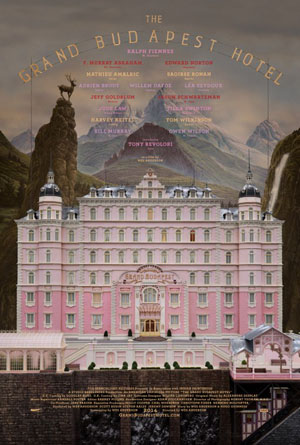 THE GRAND BUDAPEST HOTEL
THE GRAND BUDAPEST HOTEL(R)
***** (out of 5)
March 7, 2014
STARRING
Ralph Fiennes as M. GUSTAVE H.
Tony Revolori as YOUNG ZERO MOUSTAFA
F. Murray Abraham as OLD ZERO MOUSTAFA
Mathieu Amalric as SERGE X.
Adrien Brody as DMITRI DESGOFFE-UND-TAXIS
Willem Dafoe as J.G. JOPLING
Jeff Goldblum as DEPUTY KOVACS
Jude Law as YOUNG WRITER
Harvey Keitel as LUDWIG
Bill Murray as M. IVAN
Edward Norton as INSPECTOR HENCKELS
Saoirse Ronan as AGATHA
Studio: Fox Searchlight
Directed by: Wes Anderson
BY KEVIN CARR
Listen to Kevin’s radio review…
When it comes to the auteur theory, no one defines it more than Wes Anderson. Like other distinctive directors like Stanley Kubrick, Tim Burton and even Michael Bay, I’d only have to watch a few seconds of a film to recognize it as one of Wes Anderson’s.
I have been a fan of his work since I saw “The Royal Tenenbaums” almost fifteen years ago. I had seen both “Bottle Rocket” and “Rushmore,” but Anderson’s distinct style hadn’t fully formed until his next film, which I still consider his crowning masterpiece. And as much as I’ve liked everything he’s done since then – particularly “Fantastic Mr. Fox” and “Moonrise Kingdom” – no film has even come close to matching “The Royal Tenenbaums”… until now.
“Tenenbaums” marked the full maturation of Anderson as a director. Some of his works have been derivative of his own style (like “The Life Aquatic”). Others have been obvious diversions from what he’s done before (like the less-revered but still-charming “The Darjeeling Limited”). “The Grand Budapest Hotel” is as great as a film – complex and stirring yet warm and rich – as “Tenenbaums,” but entirely different.
The story is told in three perspectives in three different time frames. It is also told in three literal different frames, utilizing three separate aspect ratios for each time period. The bulk of the story follows a concierge named M. Gustave H. (Ralph Fiennes), who ends up on a bizarre adventure with the new lobby boy Zero Moustafa (Tony Revolori). They travel across a border build-up to attend the reading of the will of a hotel patron whom Gustave serviced in every way possible. When it is discovered that she left a priceless painting to Gustave, he is framed for crimes and under the watch of her murderous relatives.
Like Anderson’s other films, the story is expertly written with brilliantly quirky characters throughout, doing some unexpected things in an unconventional plot. The film is populated by one of the most impressive casts I’ve ever seen, featuring many actors the have appeared in previous Anderson films. In this sense, Anderson is the modern day Woody Allen (without the molestation allegations, of course), commanding the presence of half of the Hollywood elite.
But surrounding the story is a gorgeous film. Rich production design that uses color in unexpected ways, “The Grand Budapest Hotel” is a wonder to behold.
It’s also an interesting choice that Anderson chooses the Academy frame – a 4:3 aspect ratio most are familiar with for standard tube televisions – for the bulk of the film. Many people consider this an inferior aspect ratio compared to the widescreen options of 1:85 and 2:35, or the older 2:66 CinemaScope spectacles.
However, if you take a look at classic films like “Metropolis” and “Dracula,” you will see how the cinematography of that era used the vertical frame as much as the horizontal. Anderson’s cinematographer Robert Yeoman makes full use of the 4:3 ratio to present every shot almost as a work of art.
Of course, if you don’t like Anderson’s films, you’ll probably want to skip this because everything that people love about Anderson as a director is seen in this movie. However, if you are a fan like me, you need to see this movie as soon as possible.
Podcast: Play in new window | Download
